|
|
|
 |
|
|
|
|
|
|
|
Data
Presentation Manager (DPM) |
|
| When the HyPneu
software runs a simulation, the results are stored in a .FOC file. Data Presentation
Manager (DPM) presents these results to the user in a graphical environment. A variety of
options allow the user to create X-Y plots with single or multiple scale axes. In
addition, contour plotting is available for three-dimensional data. |
|
|
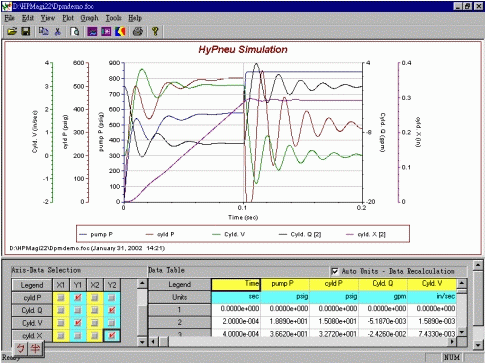 |
|
[Top of this page] |
|
|
|
Unit Conversion Manager (UCM) |
|
| Magi
Unit Conversion Manager (UCM) is a program that allows the user to convert a variety of
different units with the click of the mouse. The information gathered can be customized,
then stored on a screen, and later printed off for the user's convenience. |
|
|
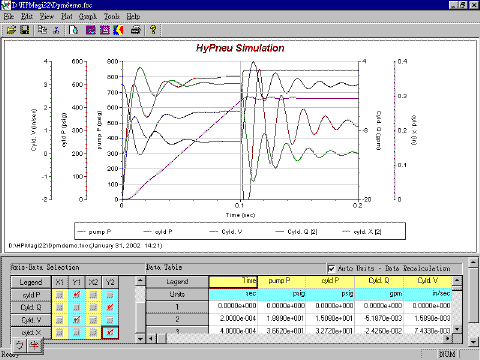 |
|
[Top of this page] |
|
|
|
Fluid Property Manager (FPM) |
|
| Magi
Fluid Property Manager (FPM) is a program that holds information on hydraulic fluids and
allows the user to store information on different fluids for future use in Magi programs.
This program simply gives a standardized information sheet for each fluid that has been
entered into the database. |
|
|
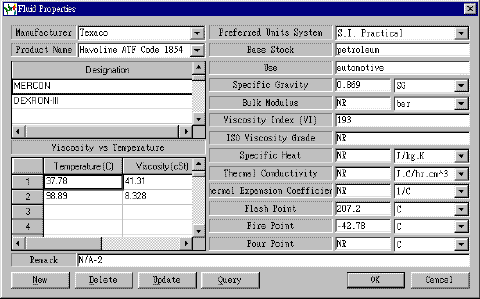 |
|
[Top of this page] |
|
|
|
Fluid
Viscosity Calculator (FVC) |
|
| Magi Fluid Viscosity Calculator (FVC) is
a program that allows the user to calculate the viscosity of a fluid at varying
temperatures and pressures. It uses the following equation for temperature variations:
|
|
|
|
|
|
where |
T = Temperature |
|
c = A constant varies from 0.75 at 0.4
cSt to 0.6 at 1.5 cSt and above |
|
£h= Kinematic viscosity |
|
A,B = Constants given for a specific fluid |
|
|
| For pressure variations
Magi FVC uses the equation: |
|
|
|
|
|
where |
£gp
= Viscosity at a specific pressure |
|
c = A
constant |
|
£g0 = Viscosity at
atmospheric pressure |
|
P = Pressure |
|
|
| For more information about the
temperature and pressure effects on viscosity, see the Hydraulic Fluids chapter of the "Hydraulic System Design for Service Assurance" book. Fluid
Viscosity Calculator (FVC) also allows you to graphically represent the viscosity of a
fluid versus the operating temperature. This helps you with the decision of what type of
fluid to use. |
|
|
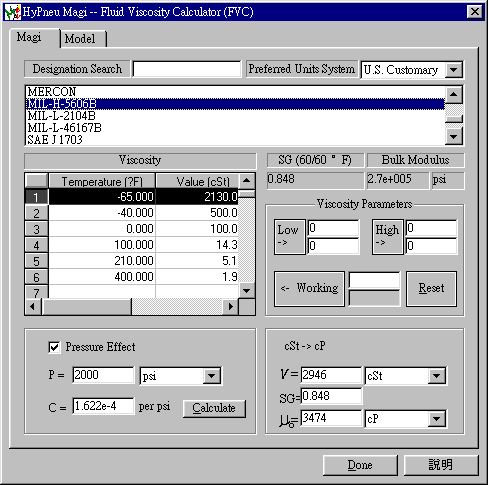 |
|
[Top of this page] |
|
|
|
Cylinder
Structural Integrity Analyzer (CSIA) |
|
| Cylinder
Structural Integrity Analyzer (CSIA) is a program that deals with the calculation of the
load that a cylinder can withstand before failure. The values of these variables change
with the way the cylinder is mounted. For more information about the equations and their
variables, see the Linear Actuators chapter of the "Hydraulic Component Design and Selection" book. As with other
Magi programs, Magi CSIA will solve for any of these variables when all of the others have
been entered. Magi CSIA will also graph the structural integrity of the cylinder so the
user can predict what the critical load of the cylinder is at different lengths of the
rod. |
|
|
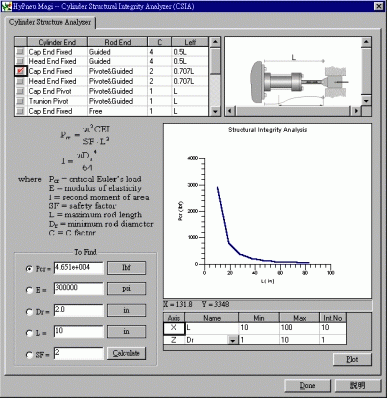 |
|
[Top of this page] |
|
|
|
Pump Performance Analyzer
(PPA) |
|
| Magi Pump Performance Analyzer (PPA) allows the user to evaluate or
predict the performance of any pump at any condition possible. Magi PPA uses test data
inputted by you or read from a stored file such as the file pump.pmp. Once the data has
been entered you must specify the operating temperature and the type of fluid that the
pump will be working with. |
| The type of fluid and operating temperature will affect the viscosity
value which Magi PPA will use to calculate pump displacement (Dp), breakaway torque (Tc),
slip coefficient (Cs), viscous shear (drag) coefficient (CV), and the mechanical friction
coefficient (Cf). Using these values and the operating pressure and angular velocity
specified by you, Magi PPA calculates the torque, flow rate, and overall efficiency at the
specified conditions. Magi PPA can also graphically represent the efficiency of a pump
over a broad range of operating pressures and velocities. |
|
|
|
|
[Top of this page] |
|
|
|
Bulk Modulus Calculator (BMC) |
|
| Magi
Bulk Modulus Calculator (BMC) is a program that calculates the effective bulk modulus of a
fluid. With this information, Magi BMC will plot the specified fluid's bulk modulus with
respect to the percent air in the liquid. BMC also calculates the effect of working
temperature and pressure individually on a fluid's bulk modulus and allows you to plot
these effects for design purposes. For more information on a fluid's bulk modulus and what
effects it, refer to the Hydraulic Fluids chapter of the "Hydraulic System Design for Service Assurance"
book. |
|
|
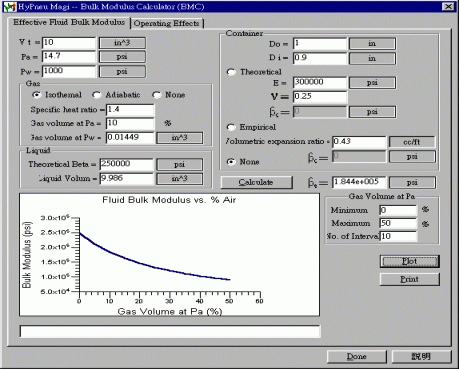 |
|
[Top of this page] |
|
|
|
Reynolds Number Calculator (RNC) |
|
| Reynolds Number Calculator
(RNC) is a program that calculates a fluids Reynolds number or if the Reynolds number is
known, then Magi RNC will solve for the hydraulic diameter, fluid velocity, or the
kinematic viscosity using the following Reynolds number equation:
|
|
|
|
|
|
where |
NR = Reynolds
Number |
u = fluid
velocity |
|
Dh = hydraulic
diameter |
£h= kinematic
viscosity |
|
£g= absolute
viscosity |
£l = fluid
specific gravity |
|
|
[Top of this page] |
|
|
|
Orifice Flow Calculator
(OFC) |
|
| Magi Orifice Flow Calculator (OFC) is a program that allows a user to
model the flow of a fluid through an orifice. In order to model the flow through an
orifice, Magi OFC uses the equation: |
|
|
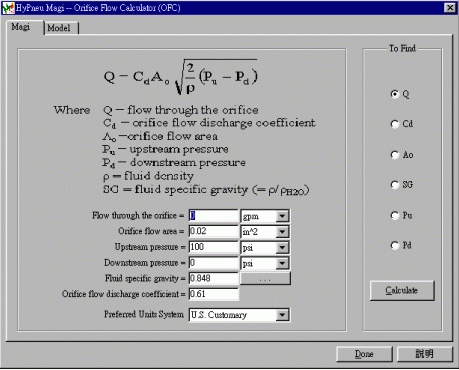 |
|
| Magi OFC will
solve for any of the variables in this equation when all of the others are known. Magi OFC
will also graphically represent the flow verses pressure for several different orifice
flow areas specified by its user. |
|
|
[Top of this page] |
|
|
|
Motor Performance Analyzer (MPA) |
|
| Magi
Motor Performance Analyzer (MPA) allows the user to evaluate or predict the performance of
any Motor they wish at any condition possible. Magi MPA does this by using test data
inputted, by the user or read from a stored file such as Motor.mot. Once the data has been
inputted the user must specify the operating temperature and the type of fluid that the
Motor will be working with. The type of fluid and operating temperature will effect the
viscosity value which Magi MPA will use to calculate geometrical displacement (Dp),
resisting torque of mechanical friction (Tc), slip coefficient (Cs), viscous shear (drag)
coefficient (CV), and the dry friction coefficient (Cf). Using these values and the users
specified operating flow rate and torque, Motor Performance Analyzer (MPA) calculates the
angular velocity, pressure, and overall efficiency at the specified conditions. Magi MPA
can also graphically represent the efficiency of a Motor over a broad range of operating
torque and flow rates. |
|
|
|
|
[Top of this page] |
|
|
|
Valve
Flow Area Calculator (VFAC) |
|
| Magi Valve Flow Area Calculator (VFAC) is a program that allows you to
calculate the flow area of different throttling devices. Magi VFAC does this using the
flow area equations that represent the different types of throttling devices. For more
information about these equations and devices, refer to the Fluid Distribution chapter in
the "Hydraulic Component Design and Selection" book. |
|
|
|
|
[Top of this page] |
|
|
|
Tube
Pressure Flow Calculator (TPFC) |
|
| Magi Tube
Pressure Flow Calculator (TPFC) allows you to calculate the pressure drop of or flow rate
in a specific tube. To do these calculations Magi TPFC uses S P Johnson's method. For more
information about this method read The Conduit System chapter in your "Hydraulic Component Design and Selection" book. |
|
|
[Top of this page] |